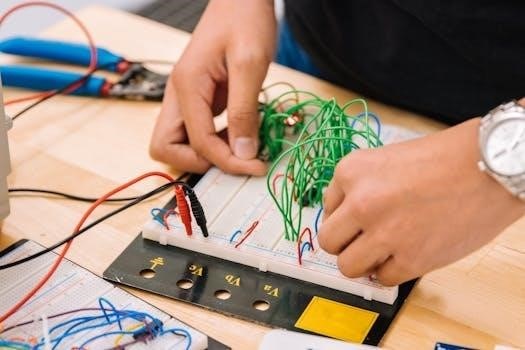Beats Solo 3 Instructions⁚ A Comprehensive Guide
Welcome to your comprehensive guide for the Beats Solo 3 Wireless headphones! This guide will walk you through everything from initial pairing to troubleshooting‚ ensuring you get the most out of your headphones. We will cover all functionalities and provide clear instructions for seamless usage.
Pairing with Apple Devices
Pairing your Beats Solo 3 with Apple devices is designed to be a seamless experience‚ especially if you’re using an iPhone or iPad with iOS 10 or later. To begin‚ ensure your headphones are powered on by pressing the power button for one second. Then‚ bring your unlocked iPhone or iPad near the headphones. A prompt will appear on your Apple device’s screen‚ guiding you through the pairing process. Simply follow the on-screen instructions to connect. Once paired‚ your Solo 3 Wireless headphones will automatically connect to all your other devices signed into the same iCloud account‚ making switching between devices incredibly convenient. This effortless integration is a hallmark of the Apple ecosystem‚ providing a smooth and quick way to enjoy your audio wirelessly. There is no need to navigate through Bluetooth settings manually‚ as the instant pairing feature takes care of the technicalities. After this initial setup‚ your Beats Solo 3 are ready for use with all your Apple products. If you don’t see the prompt‚ you may need to ensure Bluetooth is enabled on your Apple device.
Pairing with Android and Other Bluetooth Devices
Pairing your Beats Solo 3 with Android devices or other Bluetooth-enabled devices is straightforward‚ although it requires slightly different steps than pairing with Apple products. First‚ make sure your headphones are powered on. To initiate pairing mode‚ press and hold the power button on the right ear cup for about three seconds‚ until the LED indicator begins to blink. This indicates that your Solo 3 headphones are discoverable. Now‚ navigate to the Bluetooth settings on your Android device or other Bluetooth source. Look for the option to add or search for new devices. From the list of available devices‚ select “Beats Solo3.” Once selected‚ the pairing process will complete‚ and your device will connect to the headphones. If you have the Beats app installed on your Android device‚ it may streamline this pairing process. After the initial pairing‚ your headphones should automatically reconnect to your device when both are powered on and within range. Remember‚ if you experience any pairing issues‚ try turning the headphones off and then back on‚ repeating the pairing process. Make sure that no other devices are connected to your Beats.
Powering On and Off
The power button on your Beats Solo 3 is located on the right earcup‚ and it is a multi-functional button‚ so using it is simple. To power on your Beats Solo 3 headphones‚ press and hold the power button for about one second. You’ll notice the LED indicator light up on the earcup‚ signaling that your headphones are turned on and ready for use. If the light does not illuminate‚ make sure the headphones are charged‚ as this can be a reason for them not turning on. To power off your Beats Solo 3‚ press and hold the same power button for one second until the LED turns off. The headphones will also shut off automatically after a period of inactivity to save battery life. Always ensure the headphones are fully powered off when not in use to preserve battery charge and prevent accidental connections. The power button is also used for other functions‚ such as pairing and controlling playback; however‚ when turning on or off‚ just press for one second. Remember‚ proper on/off usage is essential for maintaining your headphone’s battery life.

Charging the Beats Solo 3
Keeping your Beats Solo 3 charged is essential for uninterrupted listening‚ and it’s a straightforward process. To charge your headphones‚ locate the micro-USB charging port on the bottom of the right earcup. Plug the included micro-USB cable into this port and connect the other end to a USB power adapter or a computer. When charging‚ the Fuel Gauge lights on the earcup will begin to flash‚ indicating the charging process has started. The number of lights illuminated when the charger is connected indicates the current battery level. The lights will stop flashing and will remain solid when the headphones are fully charged. A quick five-minute charge can provide up to three hours of playback‚ which is very convenient when you’re in a hurry. A full charge will typically take around two hours‚ offering up to 40 hours of listening time. Always use the provided cable or a certified cable.
Using the RemoteTalk Cable
The RemoteTalk cable offers a versatile way to use your Beats Solo 3 headphones‚ particularly when you want to conserve battery life or when the battery is depleted. This cable enables a wired connection‚ bypassing the Bluetooth functionality. To use the cable‚ simply plug one end into the 3.5mm port located on the bottom of the left earcup. Then‚ connect the other end to your audio device. Once connected via the RemoteTalk cable‚ the wireless features of the headphones will be disabled‚ and you’ll be relying on the audio signal from your device. In wired mode‚ the inline RemoteTalk controls on the cable allow you to manage music playback‚ adjust volume‚ and handle phone calls. These controls usually include a central button for play/pause and call answering and side buttons for volume adjustment. The functionality of the RemoteTalk cable ensures seamless control over your audio experience without needing the wireless features.

Controlling Music and Calls

The Beats Solo 3 headphones provide intuitive controls for managing your music and calls directly from the earcups or the RemoteTalk cable. When using the headphones wirelessly‚ the “b” button on the left earcup acts as a multi-function control. A single press of the “b” button will play or pause your music. A double press skips to the next track‚ while a triple press will return to the previous track. To manage calls‚ a single press of the “b” button will answer an incoming call‚ and pressing it again will end the call. If you’re using the RemoteTalk cable‚ the inline controls offer similar functionality‚ with a central button for play/pause and call management‚ and side buttons for adjusting the volume. The controls are designed for easy access‚ allowing you to navigate your playlists and answer calls without reaching for your device. These features ensure a smooth and uninterrupted audio experience.
Activating Voice Assistant
Activating your device’s voice assistant with your Beats Solo 3 headphones is a simple process‚ allowing for hands-free control and convenience. To activate Siri on Apple devices or the default voice assistant on Android and other Bluetooth-enabled devices‚ press and hold the “b” button located on the left earcup. Once you press and hold the button‚ the voice assistant will activate‚ and you can then give commands or ask questions. This functionality allows you to make calls‚ send messages‚ set reminders‚ or control your music using just your voice‚ without needing to physically interact with your device. The “b” button acts as the primary control for engaging the voice assistant. This feature enhances the user experience‚ providing a seamless integration with your device’s smart capabilities‚ whether it’s accessing information‚ managing tasks‚ or controlling playback‚ all through simple voice commands. The process is designed to be quick and responsive‚ making it easy to stay connected and productive on the go.
Understanding the Fuel Gauge
The Beats Solo 3 headphones feature a convenient Fuel Gauge‚ which allows you to quickly check the battery level of your headphones. The Fuel Gauge is located on the right earcup and consists of a series of LED lights that illuminate to indicate the remaining charge. When you power on your headphones‚ or when they are charging‚ these lights will flash to show the current battery status. A full set of lights indicates a full charge‚ while fewer lights mean the battery is running low. This feature is incredibly useful for monitoring your battery life‚ ensuring you are never caught off guard with a depleted battery. The flashing lights during charging also provide a visual confirmation that the charging process is underway. With a quick glance at the Fuel Gauge‚ you can easily determine if your headphones are ready for extended use or if they need to be charged. This functionality is designed to keep you informed and prepared‚ allowing for a seamless listening experience without unexpected interruptions due to low battery.

Troubleshooting Pairing Issues
Experiencing difficulties pairing your Beats Solo 3? Don’t worry‚ here are some common solutions. First‚ ensure your headphones are in pairing mode; the LED light should be blinking. If not‚ press and hold the power button for 3 seconds to initiate pairing mode. Make sure that Bluetooth is activated on your device and that the Beats Solo 3 are visible in the list of devices. If they are not‚ try turning Bluetooth off and then on again on your device. If the headphones were previously connected to another device‚ they may automatically try to connect to that device first. Try disconnecting from that device or forget the headphones in the Bluetooth settings. Also‚ consider moving closer to your device to ensure that you are within the Bluetooth range. If the problem persists‚ try restarting both your headphones and your device. Finally‚ if all other steps fail‚ a reset of your Beats Solo 3 may be necessary‚ which we will cover in another section. These steps should help resolve the most common pairing issues.
Resetting the Beats Solo 3
If you are still experiencing issues with your Beats Solo 3‚ a reset might be the solution. To reset your headphones‚ you’ll need to press and hold both the power button and the volume down button simultaneously for 10 seconds. The Fuel Gauge lights will flash‚ indicating that the reset process has begun. After the lights flash‚ release the buttons‚ and your Beats Solo 3 should be reset to their factory default settings. Once reset‚ you will need to pair them again with your device. This action will erase all previous connections and settings stored in the headphones‚ so you will need to go through the pairing process again. Resetting is a helpful step when troubleshooting persistent connection problems‚ unusual behavior‚ or if you plan on selling or giving your headphones away. This will ensure that no previous device settings interfere with a new connection. Remember to pair your headphones as if they were brand new after completing the reset. This step can be crucial in resolving various issues.








































